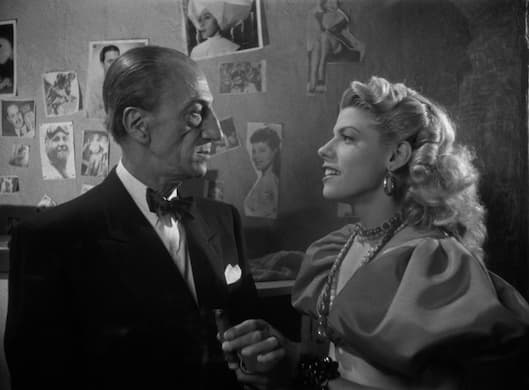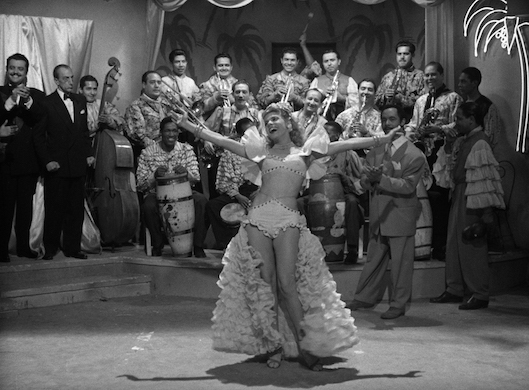If You Don’t Know Ninón Sevilla, Film Forum Is Offering a Chance
The star of ‘Victims of Sin’ is an actress of Cuban origin who forsook plans to enter a nunnery upon realizing that there was fun, fame, and fortune to be had as a cabaret dancer.

A young woman bears a child out of wedlock. Rather than incur the wrath of the boy’s father, who also happens to be her pimp, she dumps the baby in a trash can. A colleague rescues the boy, informally adopts the child, and is summarily fired from her job for doing so. She then begins working as a prostitute, only to be taken up by a potential john — one who has more charitable views of parenting than the child’s biological parents.
The man and woman reach an agreement, raise the boy together, provide him with love, and establish a degree of mutual respect for each other. Does it last? Given the seedy environs in which the characters are ensconced and, especially, the moody chiaroscuro in which they are bathed, one would hesitate to bet on the affirmative. Sure enough: Bad luck arrives. Revenge, penury, imprisonment, jealousy, and an abundance of murder ensue. That, and some racy dance numbers. “Victims of Sin” (1951), you see, is a musical.
Starting Friday, Film Forum is hosting a week-long run of the film, pegging this “unseen gem of [the] golden age of Mexican cinema” as a “musical noir.” “Victims of Sin” is an example of cabaretera, a sensationalist blend of melodrama, music, and cine de arrabal — roughly, the Mexican equivalent of neorealism. Imagine “Guys and Dolls” by way of “Los Olvidados” as overseen by Robert Siodmak, the director of seamy fare like “The Killers” (1946) and “Criss Cross” (1949). Oh, and don’t forget to add a top-flight band and a fetching chanteuse.
The star of “Victims of Sin” is Ninón Sevilla (1921-2015), an actress of Cuban origin who forsook plans to enter a nunnery upon realizing that there was fun, fame, and fortune to be had as a cabaret dancer. It was while on tour in Mexico with an Argentinian singer, Libertad Lamarque, that Sevilla caught the eye of the local entertainment industry and was offered film roles. Paramount and Columbia Pictures came knocking as well.

Why she turned down Hollywood is unknown, but “The Golden Venus” did well by putting up her shingle south of the border. She became a star, a sex symbol, and a fashion plate. Combining the silky elegance of Rita Hayworth with the earthy demeanor of Alice Faye, Sevilla went on to garner an international following. A young Francois Truffaut wrote that “from now on we must take note of Ninón Sevilla … from her inflamed look to her fiery mouth, everything is heightened in Ninón (her forehead, her lashes, her noses, her upper lip, her throat, her voice).” Truffaut was enamored.
How could he not be? Whether shimmying across the dance floor or striking a beatific pose reminiscent of a Bellini Madonna, Sevilla is magnetic, a glamorous admixture of confidence, composure, good faith, and unencumbered sexuality. The rest of the cast have a hard time holding their own in her presence — with the notable exception of Francisco Reiguera, an actor of noble carriage and a predatory profile. He plays Don Gonzalo, the stage manager at Cabaret Changoo, a gargoyle-like figure who seems to have escaped from the darker clutches of silent cinema.
Director Emilio Fernández cuts an interesting figure. Nicknamed “El Indio” because of his Native American ancestry, he fought in the Mexican Revolution, found work as an actor in the United States when that effort failed, and later returned to his native country and became a national treasure. He directed some 42 pictures, including “Maria Candelaria” (1943), the winner of Palme d’Or at that year’s Cannes Film Festival. He continued to act in American films, working for such stalwart directors as John Huston and Sam Peckinpah.
With “Victims of Sin,” Fernández proves more adept at establishing ambiance than navigating dancers — his framing of the musical numbers is stolid. He did have the good sense to hire Gabriel Figuoura, a cinematographer who studied under the legendary Gregg Toland. As previously mentioned, the picture is marked by a virtuoso deployment of light and shadow, and survives as an exemplar of noir mise en scène. Sometimes black and white are the only colors you need — in addition, of course, to an actress as magnetic as Sevilla.

